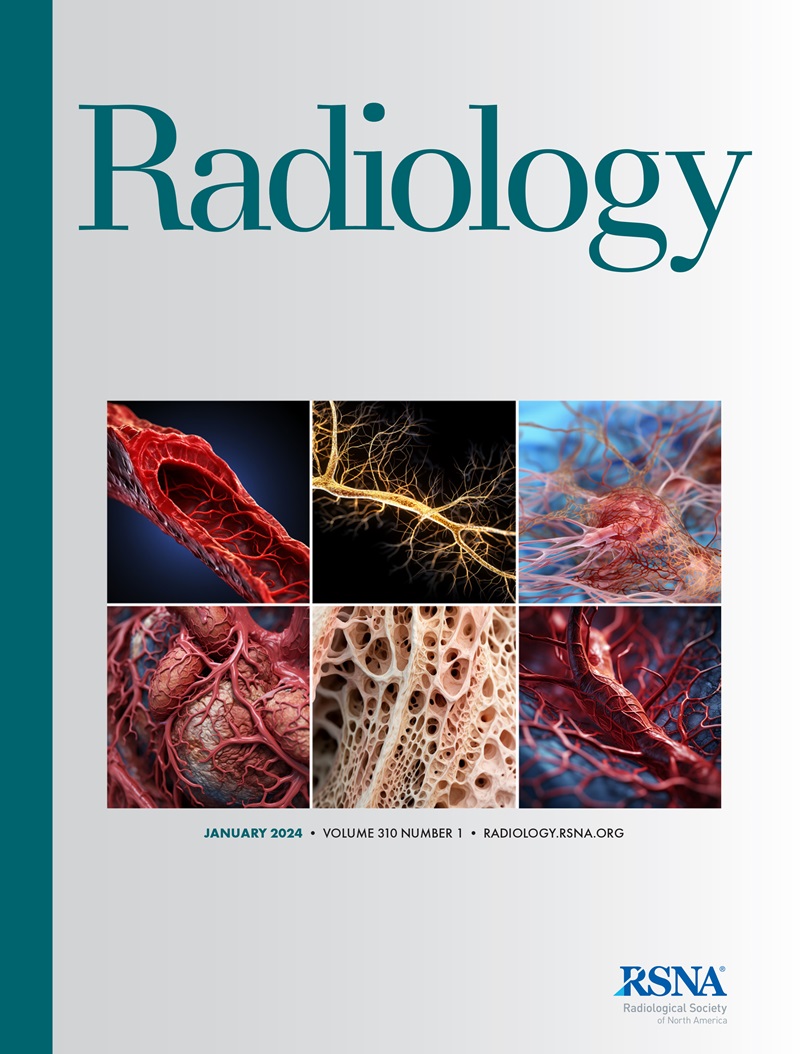Corinne E Wessner, Flemming Forsberg, Andrej Lyshchik, Patrick O'Kane, Kristen Bradigan, Ji-Bin Liu, Lauren J Delaney, Kevin Anton, Stephen R Topper, Jesse Civan, Warren Maley, Scott W Keith, Colette M Shaw, John R Eisenbrey
下载PDF
{"title":"基于微泡的肝细胞癌放射增敏:II期随机试验的安全性和有效性评估。","authors":"Corinne E Wessner, Flemming Forsberg, Andrej Lyshchik, Patrick O'Kane, Kristen Bradigan, Ji-Bin Liu, Lauren J Delaney, Kevin Anton, Stephen R Topper, Jesse Civan, Warren Maley, Scott W Keith, Colette M Shaw, John R Eisenbrey","doi":"10.1148/radiol.250083","DOIUrl":null,"url":null,"abstract":"<p><p>Background US contrast agents are gas-filled microbubbles that can be disrupted locally, such as via ultrasound-triggered microbubble destruction (UTMD), which can cause bioeffects that sensitize tumors to radiation. However, the efficacy and safety of UTMD combined with radiation therapy in participants with hepatocellular carcinoma (HCC) are unknown. Purpose To determine the treatment efficacy and safety of UTMD in participants with HCC receiving yttrium 90 (<sup>90</sup>Y) transarterial radioembolization (TARE). Materials and Methods In this prospective phase II clinical trial conducted from July 2017 to February 2024, participants with HCC scheduled for <sup>90</sup>Y-TARE were randomly assigned to undergo <sup>90</sup>Y-TARE with three UTMD sessions (treatment group) or <sup>90</sup>Y-TARE alone (control group). The primary end point was treatment response evaluated at MRI or CT using modified Response Evaluation Criteria in Solid Tumors. Secondary end points included safety, overall survival, time to next treatment, rate of liver transplantation, and pathologic response in the event of transplantation. Changes in general laboratory values and vital signs were compared using unpaired and paired <i>t</i> tests, survival and time to next treatment between groups were compared between groups using log-rank tests, and treatment response distribution was compared between groups using the Mann-Whitney <i>U</i> test. Results The study sample consisted of 98 participants (mean age, 69 years ± 8.4 [SD]; 71 men). The safety analysis showed no evidence of a difference in vital signs before versus after the initial UTMD session in the treatment group (all <i>P</i> ≥ .07). There was also no evidence of a difference in changes in general laboratory values from before to after treatment between the treatment and control groups (all <i>P</i> ≥ .08). In the control group, 34% (17 of 50) of participants had stable disease, 22% (11 of 50) had partial response, and 44% (22 of 50) had complete response; in the treatment group, 4% (two of 48) had stable disease, 35% (17 of 48) had partial response, and 60% (29 of 48) had complete response. Thus, UTMD increased the proportion of participants who experienced complete or partial response by 30 percentage points (96% [46 of 48] vs 66% [33 of 50]; <i>P</i> = .01). Overall survival was higher in the treatment group than in the control group (mortality hazard ratio, 0.51 [95% CI: 0.28, 0.95]; <i>P</i> = .03). Conclusion Compared with only <sup>90</sup>Y-TARE, adding microbubble-based radiosensitization via UTMD to <sup>90</sup>Y-TARE in the treatment of HCC had similar safety, provided improved treatment response, and prolonged survival. ClinicalTrials.gov Identifier: NCT03199274 © RSNA, 2025 <i>Supplemental material is available for this article.</i></p>","PeriodicalId":20896,"journal":{"name":"Radiology","volume":"316 3","pages":"e250083"},"PeriodicalIF":15.2000,"publicationDate":"2025-09-01","publicationTypes":"Journal Article","fieldsOfStudy":null,"isOpenAccess":false,"openAccessPdf":"https://www.ncbi.nlm.nih.gov/pmc/articles/PMC12501628/pdf/","citationCount":"0","resultStr":"{\"title\":\"Microbubble-based Radiosensitization of Hepatocellular Carcinoma: Evaluation of Safety and Efficacy in a Phase II Randomized Trial.\",\"authors\":\"Corinne E Wessner, Flemming Forsberg, Andrej Lyshchik, Patrick O'Kane, Kristen Bradigan, Ji-Bin Liu, Lauren J Delaney, Kevin Anton, Stephen R Topper, Jesse Civan, Warren Maley, Scott W Keith, Colette M Shaw, John R Eisenbrey\",\"doi\":\"10.1148/radiol.250083\",\"DOIUrl\":null,\"url\":null,\"abstract\":\"<p><p>Background US contrast agents are gas-filled microbubbles that can be disrupted locally, such as via ultrasound-triggered microbubble destruction (UTMD), which can cause bioeffects that sensitize tumors to radiation. However, the efficacy and safety of UTMD combined with radiation therapy in participants with hepatocellular carcinoma (HCC) are unknown. Purpose To determine the treatment efficacy and safety of UTMD in participants with HCC receiving yttrium 90 (<sup>90</sup>Y) transarterial radioembolization (TARE). Materials and Methods In this prospective phase II clinical trial conducted from July 2017 to February 2024, participants with HCC scheduled for <sup>90</sup>Y-TARE were randomly assigned to undergo <sup>90</sup>Y-TARE with three UTMD sessions (treatment group) or <sup>90</sup>Y-TARE alone (control group). The primary end point was treatment response evaluated at MRI or CT using modified Response Evaluation Criteria in Solid Tumors. Secondary end points included safety, overall survival, time to next treatment, rate of liver transplantation, and pathologic response in the event of transplantation. Changes in general laboratory values and vital signs were compared using unpaired and paired <i>t</i> tests, survival and time to next treatment between groups were compared between groups using log-rank tests, and treatment response distribution was compared between groups using the Mann-Whitney <i>U</i> test. Results The study sample consisted of 98 participants (mean age, 69 years ± 8.4 [SD]; 71 men). The safety analysis showed no evidence of a difference in vital signs before versus after the initial UTMD session in the treatment group (all <i>P</i> ≥ .07). There was also no evidence of a difference in changes in general laboratory values from before to after treatment between the treatment and control groups (all <i>P</i> ≥ .08). In the control group, 34% (17 of 50) of participants had stable disease, 22% (11 of 50) had partial response, and 44% (22 of 50) had complete response; in the treatment group, 4% (two of 48) had stable disease, 35% (17 of 48) had partial response, and 60% (29 of 48) had complete response. Thus, UTMD increased the proportion of participants who experienced complete or partial response by 30 percentage points (96% [46 of 48] vs 66% [33 of 50]; <i>P</i> = .01). Overall survival was higher in the treatment group than in the control group (mortality hazard ratio, 0.51 [95% CI: 0.28, 0.95]; <i>P</i> = .03). Conclusion Compared with only <sup>90</sup>Y-TARE, adding microbubble-based radiosensitization via UTMD to <sup>90</sup>Y-TARE in the treatment of HCC had similar safety, provided improved treatment response, and prolonged survival. ClinicalTrials.gov Identifier: NCT03199274 © RSNA, 2025 <i>Supplemental material is available for this article.</i></p>\",\"PeriodicalId\":20896,\"journal\":{\"name\":\"Radiology\",\"volume\":\"316 3\",\"pages\":\"e250083\"},\"PeriodicalIF\":15.2000,\"publicationDate\":\"2025-09-01\",\"publicationTypes\":\"Journal Article\",\"fieldsOfStudy\":null,\"isOpenAccess\":false,\"openAccessPdf\":\"https://www.ncbi.nlm.nih.gov/pmc/articles/PMC12501628/pdf/\",\"citationCount\":\"0\",\"resultStr\":null,\"platform\":\"Semanticscholar\",\"paperid\":null,\"PeriodicalName\":\"Radiology\",\"FirstCategoryId\":\"3\",\"ListUrlMain\":\"https://doi.org/10.1148/radiol.250083\",\"RegionNum\":1,\"RegionCategory\":\"医学\",\"ArticlePicture\":[],\"TitleCN\":null,\"AbstractTextCN\":null,\"PMCID\":null,\"EPubDate\":\"\",\"PubModel\":\"\",\"JCR\":\"Q1\",\"JCRName\":\"RADIOLOGY, NUCLEAR MEDICINE & MEDICAL IMAGING\",\"Score\":null,\"Total\":0}","platform":"Semanticscholar","paperid":null,"PeriodicalName":"Radiology","FirstCategoryId":"3","ListUrlMain":"https://doi.org/10.1148/radiol.250083","RegionNum":1,"RegionCategory":"医学","ArticlePicture":[],"TitleCN":null,"AbstractTextCN":null,"PMCID":null,"EPubDate":"","PubModel":"","JCR":"Q1","JCRName":"RADIOLOGY, NUCLEAR MEDICINE & MEDICAL IMAGING","Score":null,"Total":0}
引用次数: 0
引用
批量引用

 求助内容:
求助内容: 应助结果提醒方式:
应助结果提醒方式:


